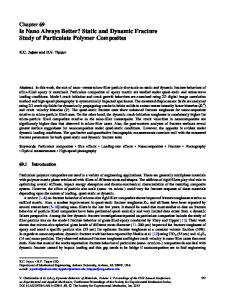Fracture Behavior of Epoxy-Based, Hybrid Particulate Composites
- PDF / 332,091 Bytes
- 6 Pages / 420.48 x 639 pts Page_size
- 99 Downloads / 372 Views
crack-surface bridging, debonding/microcracking, and crack deflection mechanisms. Addition of compliant rubber has long been used as a method to improve the fracture resistance of brittle polymers such as epoxies. Rubber particles can toughen an epoxy matrix by cavitating under the high hydrostatic tensile stresses at the crack tip and subsequently triggering shear banding to occur in the matrix adjacent to the rubber particle. Massive shear banding and plastic void growth reduce the effective crack driving force at the crack tip and shield the crack tip. The use of two modifiers in an epoxy polymer (one compliant and one rigid) may promote the simultaneous occurrence of two or more toughening mechanisms. For hybrids this may result in an additional increase in fracture toughness above the toughness for a single particle type. If the two toughening mechanisms interact in a positive fashion, a synergistic increase in toughness may be achieved in that for a given volume fraction of modifiers, the toughness of the hybrid would be greater than the additive contributions of the two modifiers separately. Synergistic toughening had been seen in some epoxy systems containing both compliant rubber particles and rigid inorganic fillers [1-5]. Azimi et al. [4,5] investigated synergistic effect in an epoxy matrix modified with a compliant rubber and hollow glass spheres and in an epoxy matrix modified with a compliant rubber and solid glass spheres. These authors specifically investigated synergistic toughening by varying the volume fraction of rubber and glass filler in the matrix, while maintaining a constant total volume fraction of 10%. A synergistic increase in toughening was observed for hybrids composite systems containing 5% rubber and 5% glass spheres and for 7.5% rubber and 2.5% glass spheres. 239 Mat. Res. Soc. Symp. Proc. Vol. 515 01998 Materials Research Society
The purpose of this investigation is to elucidate the toughening mechanisms in an epoxy polymer containing both compliant rubber particles and rigid disc-shaped particles. The fracture properties of the composite systems were determined as a function of volume fraction ratio of compliant to rigid filler as well as the average particle size (10 ýtm versus 50 ptm in diameter). Toughening mechanisms were revealed using scanning electron microscopy (SEM) and transmission optical microscopy (TOM). EXPERIMENTAL Materials The epoxy matrix used in this investigation consists of DER® 331 cured with piperidine. DER® 331 is a liquid diglycidyl ether of bisphenol A (DGEBA) with an epoxide equivalent weight of 187 g/eq. The epoxy matrix has been modified by the incorporation of boron nitride platelets and rubber particles. Advanced Ceramics Corp provided the boron nitride (BN) particles selected for this study. Two fine BN powders were chosen, PT®-120 (10 Jim in diameter and 1 pm thick) and PT®-I 10 (50 gtm in diameter and 5 prm thick micron). Both BN particles have a platelet or disc-shaped geometry. The rubber particles consisted of a reactive liquid carboxy termin
Data Loading...











